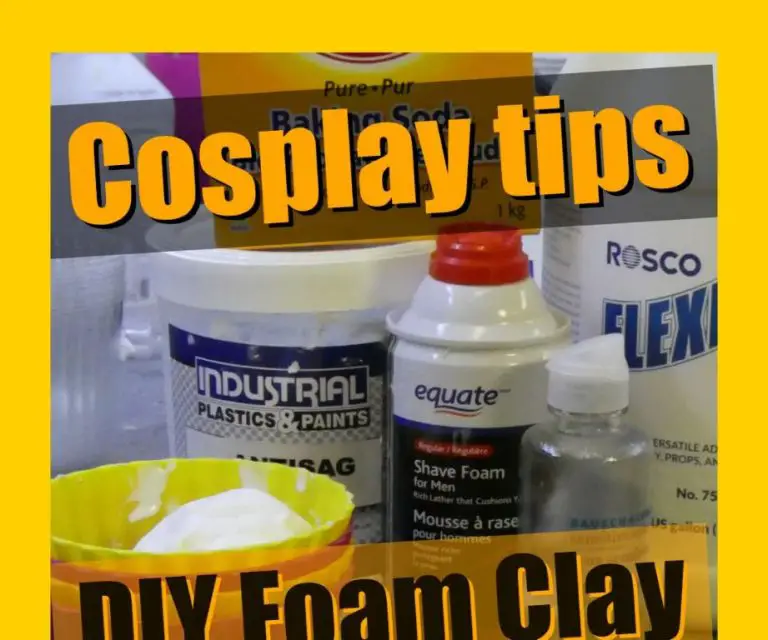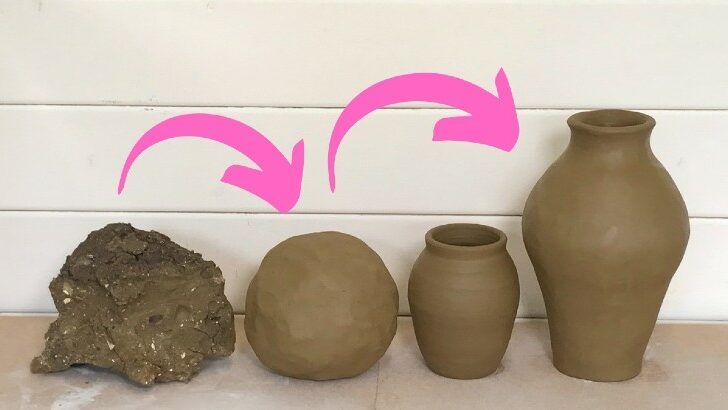Can I Use Clay From My Garden?
Clay is a naturally occurring material composed primarily of fine-grained minerals, which is plastic when wet and hard when fired. There are many different types of clay that have been used for various purposes throughout history. Some of the most common uses of clay include pottery, construction materials like bricks and tiles, cosmetics, and more recently, art supplies.
Clay can typically be found in abundance in most regions of the world, often in river beds or near other sedimentary deposits. However, not all clay is suitable for every application. The composition and quality of clay can vary greatly depending on where it is collected. So while it may be tempting to dig up and use clay in your own backyard, it’s important to test its properties before determining the appropriate uses.
Checking if it’s Clay
Clay has some unique properties that help distinguish it from other soils. Here are some simple ways to check if the soil in your yard is clay:
Plasticity – Clay is highly plastic and flexible when wet, meaning it can be molded into shapes that retain their form. Try wetting a sample of soil and rolling it into a snake shape. If you can make a snake longer than 1-2 inches before it breaks apart, it likely contains a high clay content.
Stickiness – Wet clay is sticky due to the electrostatic forces between the thin clay particles. Press a moist soil sample between your fingers – if it feels sticky, sticks to your skin, and is difficult to wash off, that’s a sign of clay.
Smoothness – Clay particles are very fine, so clay soils feel smooth instead of gritty when rubbed between your fingers. Smooth, flour-like soil is characteristic of clay.
Ribbon test – Knead moist soil into a ball and press it out between your thumb and forefinger to make a ribbon shape. Clay can make ribbons 1-2 inches long before breaking. Sandy soil won’t make ribbons at all.
Clay Types
There are three main types of clay that are commonly found and used:
Kaolin
Kaolin clay, also known as China clay, is white in color and has a fine texture. It fires to a light color and is used to make porcelain. Kaolin clay is non-plastic, meaning it does not readily bend or deform.
Bentonite
Bentonite clay expands when wet and is able to absorb large amounts of water. It has high plasticity and is commonly used for sculpting and mold making. Bentonite fires to a buff or cream color.
Ball Clay
Ball clay is very plastic and sticky. It fires to a light color and is ideal for making ceramic bodies and glazes. Ball clay helps prevent cracking and crazing in finished ceramic wares.
Testing Clay Quality
There are a few simple ways to test the quality and composition of clay from your garden before deciding how to use it:
Squeeze Test – Take a lump of clay and squeeze it in your hand. High quality clay will form into a ball that holds its shape. Lower quality clay will crumble apart.
Ribbon Test – Roll a ball of clay into a coil about 1/2 inch thick. Gently squeeze the coil between your thumb and forefinger, pulling your hands apart to stretch it. High quality clay can stretch into long thin ribbons. Lesser quality clay will break apart more easily.
Tooth Test – Bite a small piece of dried clay. High quality clay will feel smooth. Lesser quality clay will feel gritty and sandy.
Absorption Test – Leave a 1 inch ball of clay out overnight to dry completely. Then, place it in water and observe how long it takes to become saturated. Quality clay will absorb water slowly. Poor clay absorbs very quickly.
Fire Test – Carefully burn a small dried piece of clay. Quality clay will not smoke or smell bad. Poor clay may burn irregularly and give off odors.
Doing these simple hands-on tests can help determine if the composition of your garden clay is suitable for crafting and construction projects before investing significant time and effort.
Uses in Pottery
Natural clay dug fresh from the earth can be an excellent material for creating pottery, sculpture, and other ceramic artworks. Clay is prized for its plasticity when wet, which allows it to be shaped into endless forms. When fired at high temperatures, the clay hardens into a durable ceramic material.
Freshly dug clay contains natural minerals that give it its potency for firing into strong ceramics. Many potters appreciate sourcing their own clay rather than buying preprocessed commercial clays. However, natural clay direct from the ground has its limitations and must be carefully tested and processed before use in pottery or ceramics.
A high quality pottery clay needs plasticity to throw on the wheel and hold its shape without slumping or cracking before firing. Natural clay from the garden may contain impurities like rocks, roots, or sandy grit that reduce its plasticity. The clay also needs high green strength in its wet state to retain crisp detail. Some homemade clays are too lean or porous for detailed pottery work.
The clay’s firing color and temperature are critical factors too. Low quality clays may only fire to a usable hardness at lower temperatures that produce a limited range of earthy browns and reds. Higher quality clays with more fluxing elements fire into stoneware and porcelain at temperatures up to 1300°C and produce light buffs, creams, and even near whites. The homemade clay must be tested to ensure a firing temperature and range of colors suitable for the type of pottery or ceramic ware desired.
Uses in Construction
Clay can be an extremely useful and sustainable material for construction projects. One of the most common uses is for cob building. Cob is an ancient technique that combines clay, sand, straw and water to create monolithic walls. The clay acts as a binder to hold the mixture together. Cob buildings are energy efficient, natural, and beautiful. The clay walls provide thermal mass, regulating interior temperatures and reducing the need for heating and cooling.
Cob can be used to build entire structures or just components like interior walls. It is molded by hand into loaves that are stacked to form the walls. The ingredients are all natural and readily available, making cob highly affordable. It’s also very durable and can last for centuries. Cob homes have an organic, curving aesthetic unlike modern buildings. It is still used today by people seeking sustainable and ecological housing.
Beyond cob houses, clay can also be used to make earthen plasters for coating walls. When mixed with sand, straw and water, clay plaster provides a breathable and antiseptic finish. Mud bricks made from clay soil are another ancient yet effective building material. Clay is also used to make earthen floors that are smooth, durable and pleasant to walk on.
With its versatility, abundance and eco-friendly properties, clay from your own garden can be an excellent option for natural construction projects.
Clay for Cosmetics
Garden clay can be an affordable and natural alternative for skincare and cosmetics. However, it’s important to ensure any clay you use on your skin is uncontaminated. Certain clays, like bentonite and kaolin, are known for their cosmetic benefits.
Bentonite clay is very absorbent and can be used in facial masks and body wraps. It may help remove impurities from skin and improve complexion. Kaolin clay is also used in skincare for its absorbent properties. It can help cleanse skin gently.
Before using garden clay for skincare, check that it does not contain contaminants like bacteria, chemicals, or heavy metals. Clay deposits near mining sites or farms using pesticides are more likely to be contaminated. It’s safest to obtain clay from deep unexposed deposits far from pollution sources.
To purify garden clay, start by letting it dry fully in the sun. Then mix the clay with clean water in a tub and allow the heavier pieces and grit to settle at the bottom. Carefully pour off the cleaner clay water into another container without stirring up the sediment, and let it settle again. Repeat this washing process 2-3 times until you have smooth, clean clay.
Always do a skin patch test before applying garden clay masks or treatments. Start with a small amount on your arm for at least 24 hours to check for any irritation or allergic reaction. Proceed cautiously and stop using if any redness or discomfort occurs.
Identifying Contaminants
When collecting clay from your own property, it’s important to be aware of potential contaminants that could make the clay unsafe or unsuitable for certain uses. Some common contaminants to look out for include:
Pesticides and herbicides: If pesticides or weed killers have been used in the area where you are collecting clay, these chemicals can leach into the soil and contaminate the clay. Look for signs of chemical use like empty containers.
Heavy metals: Clay near old structures painted with lead-based paint or industrial areas can absorb heavy metals like lead, cadmium, or arsenic. These metals don’t break down and can be toxic if clay is used for dining ware.
Bacteria and organisms: Animal waste, dead vegetation, or other organic matter mixed into clay provides food for bacteria and fungi. This can cause staining or odors.
Synthetic materials: Plastics, rubber, glass, fabrics, or metal scraps mixed into clay can compromise its workability and quality.
Salt: Clay collected near oceans or saltwater sources may contain high salt content, which can cause efflorescence or spalling during drying and firing.
Test your clay using kits or by sending a sample to a lab to determine if contaminant levels are safe for your intended use. Also inspect and clean clay thoroughly before beginning projects.
Cleaning and Processing
Once you’ve determined that the clay from your garden is usable, the next step is to clean and process it before starting your project. Here are some tips for cleaning and preparing clay:
Remove Contaminants
Look through the raw clay and remove any pebbles, roots, or other debris. Break up clumps and pick out anything that doesn’t belong.
Soak the Clay
Place the clay in a large container and cover with water. Allow it to soak for 1-3 days to fully saturate. This will soften the clay and allow the remaining sediment to settle out.
Knead the Clay
Drain off the excess water and knead the clay thoroughly. This helps distribute moisture evenly and improves the consistency.
Screen the Clay
Push the clay through a fine mesh screen to filter out any remaining particles or debris.
Allow to Dry
Let the filtered clay air dry completely before using it in projects. Drying removes excess moisture and firms up the clay.
With cleaned and processed clay, you’ll have an excellent homemade material ready for all your crafting and building needs.
Conclusion
Clay from your garden can be a versatile and free material for many projects if it is of good quality. The key factors are ensuring the clay does not contain many contaminants like twigs or stones, and testing the clay’s properties like plasticity and firing temperature. The best uses for garden clay are informal items like children’s modeling clay or hand-built pottery that does not require high performance. Construction applications would require more controlled and uniform clay. To safely use garden clay, it’s important to identify and remove contaminants through processing methods like soaking, sieving, and hand-picking. With some testing and cleaning, the clay in your backyard can be an abundant resource for creative projects.




